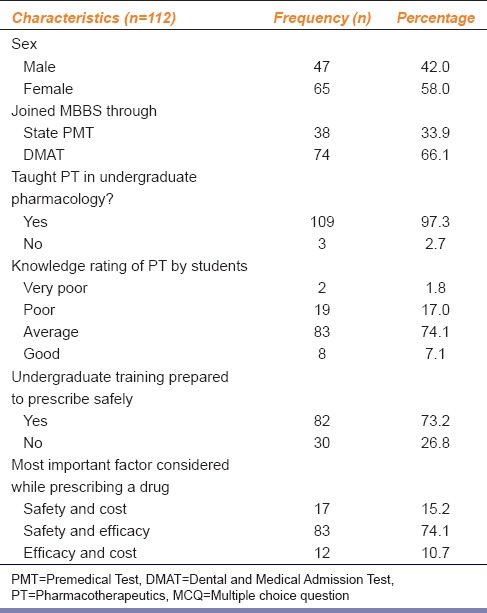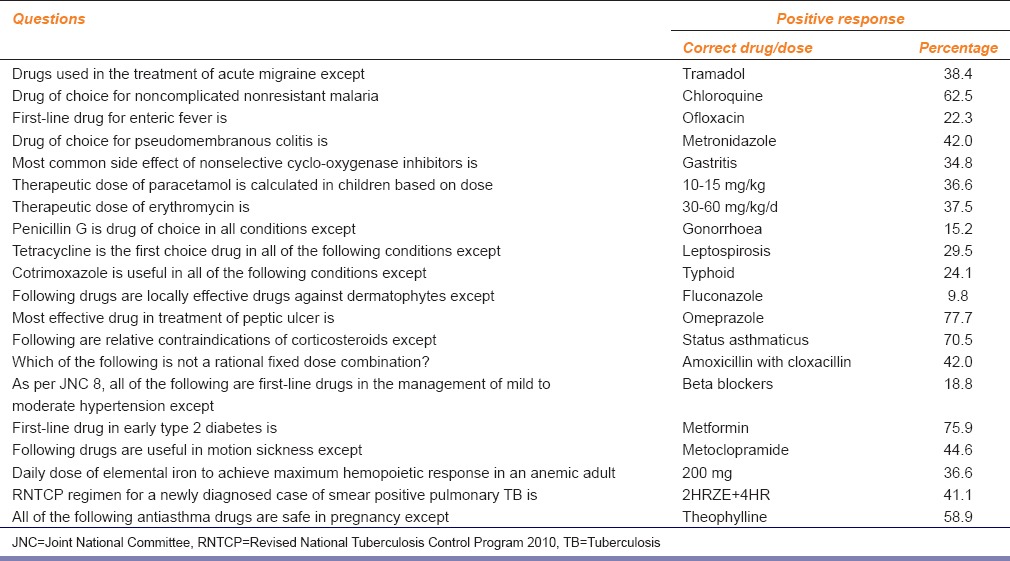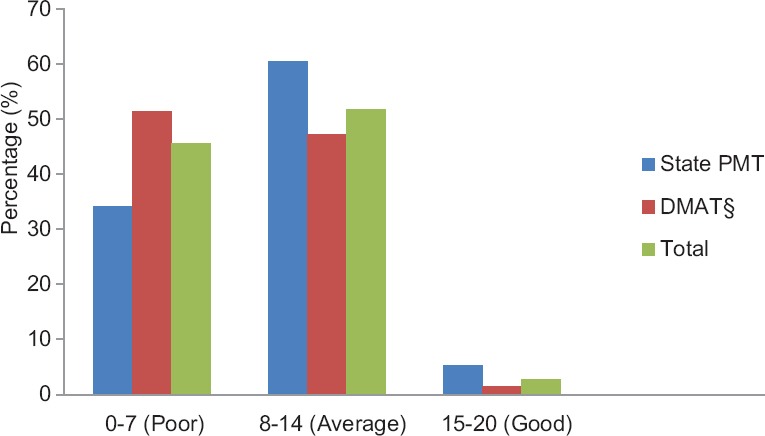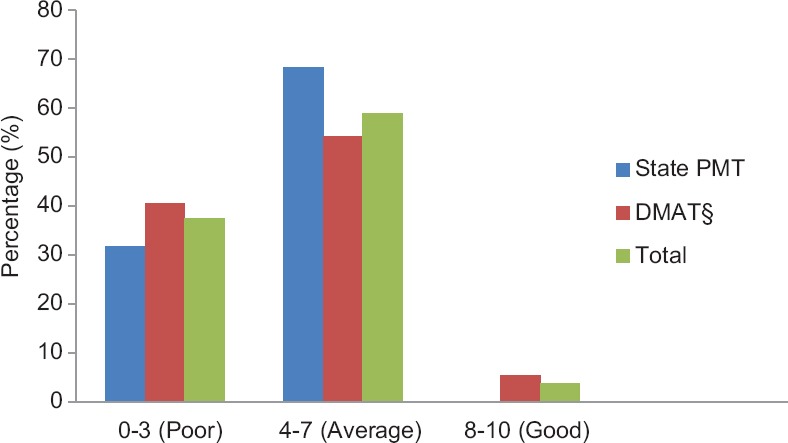Abstract
Objectives:
To assess pharmacotherapeutics (PT) knowledge of second professional medical undergraduates.
Materials and Methods:
It is a questionnaire-based cross-sectional study. The questionnaire was designed to objectively assess the current level of knowledge of PT acquired by the second MBBS students in a medical college in India. Thirty Type-A multiple choice questions (MCQs) related with the PT of common and important medical conditions and some emergency conditions were administered to 125 participants. Grading of knowledge was also done as poor, average, and good both subjectively and objectively. Descriptive statistics were used to analyze responses. Association of PT knowledge with respect to mode of admission in a medical college was analyzed with Chi-square test.
Results:
MCQs related with PT of nonemergency conditions were responded correctly by 9.8–77.7% of participants. MCQs related with PT of some emergency conditions were responded correctly by 17–66.1% of participants. No statistically significant association was observed in PT knowledge with respect to mode of admission.
Conclusion:
Gross deficiency in the PT knowledge can potentially and adversely affect future rational prescribing skills. PT knowledge about common medical conditions should be emphasized during undergraduate training program.
KEY WORDS: Knowledge, medical, pharmacotherapeutics, undergraduates
Introduction
Doctors have been providing one of the greatest services to the mankind because of which they hold a high respect in the sight of people. Thus, responsibility of maintaining high quality and standard in providing health care also rests with the doctors themselves.
Quality control is defined as “a procedure or set of procedures, intended to insure that a manufactured product or performed service adheres to a defined set of quality criteria or meets the requirements of the client or customer.”[1] In medical education this task is taken care of by the Medical Council of India.
Quality assurance is defined as “a procedure or set of procedures, intended to insure that a product or service underdevelopment meets specified requirements.”[2] In medical education, quality assurance includes the policies, systems, and the processes that are in place to maintain and improve the quality of medical education and training. Quality assurance can be done through course evaluation, peer review, structured and objective evaluation of trainees, and feedback from students and alumni. This will improve the quality of doctors produced and thereby will improve the quality of health-care services to the community.[3]
”Pharmacotherapeutics (PT) is the application of pharmacological information together with the knowledge of the disease for its prevention, mitigation or cure. Selection of the most appropriate drug, dosage and duration of treatment taking into account the specific features of a patient are a part of PT.”[4] Knowledge of PT is essential to practice medicine.
PT knowledge is a prerequisite for rational prescribing and prepares the medical undergraduates to be efficient doctors (though knowledge of prescription writing is also acquired during clinical training but is based on initial PT knowledge imparted in pharmacology during second professional year training). Very few studies have been conducted to find the PT knowledge of medical students. These studies reported deficiency in PT knowledge.[5,6] Perhaps, no formal study has been done so far to objectively assess the level of PT knowledge acquired by the second professional medical students in India. Therefore the present study was proposed to investigate PT knowledge acquired by medical undergraduates.
Materials and Methods
It is a questionnaire-based cross-sectional study. Budding doctors who have recently completed their second professional year training program and eligible for second MBBS final university examinations were included in the study. The questionnaire was designed to objectively assess the current level of knowledge of PT acquired by the second MBBS students in a medical college in India. The questionnaire also sought information about demographics, PT training, preparedness to prescribe safely, and self knowledge ratings. Thirty Type-A multiple choice questions (MCQs) related with the pharmacotherapy of common medical conditions were framed as per the prescribed guidelines of item writings.[7] MCQs were structured based on PT knowledge imparted to students during second professional training. Twenty MCQs were related with relatively nonemergency conditions and ten MCQs were related with emergency conditions like status epilepticus, anaphylactic shock, severe dehydration, diabetic ketoacidosis, etc., Test items were discussed and reviewed by senior faculty members in the department. Flawed items were either reframed or removed. Participants were instructed to mark the most appropriate option. A positive credit was awarded for each correct response. Thirty minutes time was allotted to solve the questionnaire. Grading of knowledge was also done. For nonemergency conditions 0–7, 8–14 and 15–20 correct responses were graded as poor, average and good, respectively. For emergency conditions 0–3, 4–7, 8–10 correct responses were graded as poor, average and good, respectively.
Statistical Analysis
Statistical analyses included both descriptive and inferential methods. The data were analyzed by using statistical software SPSS version 17.0 Chicago: SPSS Inc. Continuous variables were expressed as mean ± standard deviation while the results on categorical measurements were presented in numbers or percentages. Pearson's Chi-square test was used to observe statistically significant difference in PT knowledge between state Premedical Test (PMT) and Dental and Medical Admission Test (DMAT) students. P ≤ 0.05 was considered statistically significant.
Results
Of a total of 125 questionnaires administered to students, 112 were duly filled and returned thus giving a response rate of 89.6%. The mean age of participants was found to be 20.88 ± 1.27 years. Out of a total of 112 participants, 42.0% were males while rest (58.0%) were females. Nearly 66.1% of the participants got admission through DMAT while 33.9% got admission through state PMT. Most of the participants (97.3%) revealed that PT was taught in undergraduate pharmacology. They also rated their PT knowledge as good (7.1%), average (74.1%), and poor (17%). About three-fourth (73.2%) of the participants felt that undergraduate training prepared them to prescribe safely. A substantial number of participants (74.1%) felt that safety and efficacy will be the most important factors to be considered while prescribing a drug [Table 1].
Table 1.
Demographics and perception about pharmacotherapeutics among medical undergraduates in an Indian medical college

PT knowledge related with some nonemergency conditions was observed in 9.8–77.7% of participants. Most participants (77.7%) recorded rightly that most effective drug in treatment of peptic ulcer is omeprazole, followed by 75.9% who correctly identified metformin as first-line drug in early Type-2 diabetes. About three-fourth of the MCQs were responded correctly by <50.0% of the participants [Table 2].
Table 2.
Knowledge of pharmacotherapeutics related with some nonemergency conditions among medical undergraduates in an Indian medical college

PT knowledge related with some emergency conditions was observed in 17–66.1% of participants. A maximum of 66.1% participants could rightly identify first-line drug for status epilepticus, followed by 63.4% who correctly identified epinephrine as life-saving drug in anaphylactic shock. About two-third of the MCQs were responded correctly by <50.0% of the participants [Table 3].
Table 3.
Knowledge of pharmacotherapeutics related with some emergency conditions among medical undergraduates in an Indian medical college

Between the groups (PMT vs. DMAT), comparison for PT knowledge was done for both nonemergency and emergency conditions. No statistically significant difference was observed between the groups [Figures 1 and 2].
Figure 1.

Comparison of pharmacotherapeutics knowledge of some nonemergency conditions between state PMT versus DMAT students (n = 112). PMT: Pre-medical Test, DMAT: Dental and Medical Admission Test, §P > 0.05, statistically not significant versus state PMT (Pearson's Chi-square test)
Figure 2.

Comparison of pharmacotherapeutics knowledge of some emergency conditions between state PMT versus DMAT students (n = 112). PMT: Premedical Test, DMAT: Dental and Medical Admission Test, §P > 0.05, statistically not significant versus state PMT (Pearson's Chi-square test)
Discussion
Pharmacology is considered to be the backbone of medical practice. It is taught in second professional year of medicine. Apart from imparting knowledge about pharmacokinetics and pharmacodynamics of drugs, providing PT knowledge is also an integral part of pharmacology curriculum.
The present study was designed to objectively find the level of PT knowledge acquired by medical undergraduates who have completed their second professional training program while pursuing MBBS. As it is a private medical college, students from both state PMT and DMAT got admission as per the state government rules.
Most of the participants (74.1%) opined their knowledge of PT as average while 17% considered their knowledge of PT as poor. Most of the students (73.2%) were confident of prescribing safely while 26% were not confident about it. In a study from India, 7.5%- 81.6% medical students considered themselves competent to prescribe antimicrobials for various infections.[8] In the present study, 74.1% expressed rightly, safety and efficacy as most important factor while 15.2% felt safety and cost and 10.7% considered efficacy and cost as the most important factor, indicating a scope of improvement in their knowledge and perception towards PT [Table 1].
Majority of the participants expressed correctly about the effective treatment for peptic ulcer (77.7%), first-line drug in early Type-2 diabetes (75.9%) and relative contraindications of steroids (70.5%). However, only 22.3% could identify correct treatment of typhoid, a common infectious disease in India, indicating deficiency in knowledge [Table 2]. Beta blockers are no longer first choice drugs as per the Joint National Committee 8th recommendation about treatment of hypertension, but only 18.8% knew that [Table 2].[9]
Nonselective cyclooxygenase inhibitors are one of the most commonly prescribed drugs for various painful inflammatory conditions and are also the leading cause of adverse drug reactions.[10] Gastritis is their most common side effect, but only 34.8% could identify it correctly reflecting lack of knowledge about safety aspect of nonselective cyclooxygenase inhibitors.
Paracetamol is the most common anti-pyretic drug used in paediatric population, while erythromycin is a popular antibacterial; their doses calculation should be known to participants. However, only 36.6% and 37.5% respectively, were able to calculate their doses correctly, indicating deficiency in knowledge [Table 2].
Tramadol is an opioid analgesic and is not effective in the treatment of migraine but 38.4% participants considered it to be useful.[11] Chloroquine is the drug of choice for treating noncomplicating nonresistant malaria but only 62.5% participants reported it correctly, while 58.9% participants knew that antiasthmatic drug theophylline was unsafe in pregnancy, pointing deficiency in their knowledge [Table 2].
Pseudomembranous colitis is a known adverse effect of antibiotics like cephalosporins, tetracyclins, and clindamycin, but can be treated effectively by metronidazole was responded correctly by only 40% participants. Tuberculosis (TB) is a serious and common health problem in India. A national program is being run for tackling it in the form of Revised National TB Control Program (RNTCP).[12] It is expected from participants to be aware of the regimens used for treating this problem, however, only 41.1% were able to identify correct regimen for category I patients under RNTCP, showing gross deficiency in the knowledge [Table 2].
Iron deficiency anemia is the most common anemic condition and is treated by iron replacement therapy.[13] It was expected from participants to know the correct dose for maximum response which was exhibited by only 36.6% population, indicating significant deficiency in knowledge [Table 2].
Labyrinthine suppressants such as anticholinergics and antihistaminics with anticholinergic property have been found to be useful in the prevention of motion sickness. Metoclopramide is an antiemetic which prominently works by blocking D2 receptor in vomiting center and is not a labyrinthine suppressant, therefore not effective in prevention of motion sickness.[14] However, only 44.6% participants responded correctly showing deficiency in their knowledge [Table 2].
Amoxicillin is active against penicillin G sensitive Gram-positive and some Gram-negative organisms. Cloxacillin is a penicillinase-resistant penicillin having lesser activity against penicillin G sensitive organisms. Their combination does not enhance spectrum and potency, therefore is irrational.[15] Only 42% participants could identify it reflecting deficiency in knowledge. Deficiency in PT knowledge was also reported for important antimicrobials like penicillin G (15.2%), tetracycline (29.5%), cotrimoxazole (24.1%), and fluconazole 9.8 (%) [Table 2]. In a European multicentric study, 67–92% medical students did not feel confident of prescribing antibiotics exhibiting lack of knowledge.[5] Another study from India reported lack of knowledge among medical students about rational use of antibiotics.[16]
Lack of knowledge was also reported with regard to the use of drugs in emergency conditions such as status epilepticus (66.1%), anaphylactic shock (63.4%), severe dehydration (50.9%), and hypertensive emergency (32.1%) [Table 3]. Organophosphorous poisoning is a common medical emergency condition which is treated by atropine. Only 49.1% participants reported correct dose of atropine. Diabetic ketoacidosis is also a very commonly countered medical emergency in India. It is shocking to find that only 22.3% knew about the use of regular insulin to correct metabolic derangement in diabetic ketoacidosis [Table 3].
Ondansetron is a 5-HT3 antagonist which is used as antiemetic drug. Its safety in pregnancy is not proven and therefore is not recommended for treating pregnancy associated vomiting.[17] However, just 22.3% participants were able to identify it. Ringer lactate is the first line of intravenous fluid required to correct severe dehydration but only 43.8% participants reported it correctly.
Gross lack of knowledge was also observed in relation to useful drugs in acute angina (48.2%) and status asthmaticus (17.0%) [Table 3]. The present study found gross deficiency in the PT knowledge of budding doctors. It can potentially and adversely affect their future prescribing skills. A European study reported knowledge of clinical pharmacology and pharmacotherapy in the range of 65.3% to 79.2% among medical students using different set of parameters, i.e., pharmacokinetics, pharmacodynamics, prescribing in special group, drug interactions, etc.[6] A Chinese multi-centric study reported lack of knowledge about rational antibiotic use among 27.4%-92.9% medical students.[18] Lack of pharmacotherapeutics knowledge among medical students appears to be a global problem which requires serious attention.
In the present study, most of the participants rated their PT knowledge as average (74.1%) and 7.1% rated as good, whereas only 17% self rated their PT knowledge as poor [Table 1]. However, this is in contrast to the objective findings in which 45.5% and 37.5% participants had poor PT knowledge related with some nonemergency and emergency conditions, respectively [Figures 1 and 2]. This shows that objective evaluation gives a better idea about the level of knowledge than subjective ratings by the participants.
Though PT is being taught as a part of pharmacology curriculum, high percent of poor category of knowledge in both nonemergency (47.5%) and emergency (37.5%) situations demands that there is a dire need to focus on providing training to medical undergraduates about PT knowledge related with important and common emergency and nonemergency conditions [Figures 1 and 2]. The findings of the present study may help in improving teaching & learning activities for second year MBBS students, which in turn may improve their future prescribing skills.
It was anticipated that students getting admission through state PMT might perform better than those getting admission through DMAT. PT knowledge was compared for nonemergency and emergency conditions. However, between the groups statistical comparison did not show significant difference in the PT knowledge for both nonemergency and emergency conditions [Figures 1 and 2]. This clearly shows that PT knowledge acquisition is not influenced by the mode of admission in a medical college. However, this needs to be substantiated by more studies.
This is a single center study involving limited numbers of participants; therefore, results of the study may not be extrapolated to other institutes. A large multicentric study may provide greater insight into the level of PT knowledge acquired by medical undergraduates in India. Questions are related with limited drugs and clinical settings; however it gives an idea about the status of knowledge of PT among second professional medical students.
Conclusion
‘The present study provides valuable information about the status of PT knowledge of students in a medical college in India which may be utilised for improving undergraduate training. The findings suggest that there is a dire need to lay more emphasis on training medical students to select a drug rationally from the number of therapeutic options available these days for common medical conditions. This will improve their future prescribing skills and eventually reduce avoidable medication errors. A curriculum based on learning objectives in which the desired level of PT competence of medical students has been determined is the need of hour.
Financial Support and Sponsorship
Nil.
Conflicts of Interest
There are no conflicts of interest.
Acknowledgment
We are thankful to all the doctors in the Department of Pharmacology for helping in administration of test. We also thank Dr. S. D. Tonpay, Professor, for his valuable suggestions. We are also thankful to all the participants who are involved in this study.
References
- 1.Quality Control (QC) [Last accessed on 2016 Jan 30]. Available from: http://www.whatis.techtarget.com/definition/quality-control-QC .
- 2.Biggs J. The reflective institution: Assuring and enhancing the quality of teaching and learning. High Educ. 2001;41:221–38. [Google Scholar]
- 3.Joshi MA. Quality assurance in medical education. Indian J Pharmacol. 2012;44:285–7. doi: 10.4103/0253-7613.96295. [DOI] [PMC free article] [PubMed] [Google Scholar]
- 4.Tripathi KD. Essentials of Medical Pharmacology. 7th ed. New Delhi: Jaypee Brothers Medical Publisher; 2014. Introduction, routes of drug administration; pp. 765–86. [Google Scholar]
- 5.Dyar OJ, Pulcini C, Howard P, Nathwani D. ESGAP (ESCMID Study Group for Antibiotic Policies). European medical students: A first multicentre study of knowledge, attitudes and perceptions of antibiotic prescribing and antibiotic resistance. J Antimicrob Chemother. 2014;69:842–6. doi: 10.1093/jac/dkt440. [DOI] [PubMed] [Google Scholar]
- 6.Keijsers CJ, Brouwers JR, de Wildt DJ, Custers EJ, Ten Cate OT, Hazen AC, et al. Acomparison of medical and pharmacy students’ knowledge and skills of pharmacology and pharmacotherapy. Br J Clin Pharmacol. 2014;78:781–8. doi: 10.1111/bcp.12396. [DOI] [PMC free article] [PubMed] [Google Scholar]
- 7.Haladyna TM, Downing SM. A taxonomy of multiple choice item-writing rules. Applied measurement in education. 1989;2:37–50. [Google Scholar]
- 8.Sharma K, Jain P, Sharma A. Knowledge, attitude and perception of medical and dental undergraduates about antimicrobial stewardship. Indian J Pharmacol. 2015;47:676–9. doi: 10.4103/0253-7613.169572. [DOI] [PMC free article] [PubMed] [Google Scholar]
- 9.James PA, Oparil S, Carter BL, Cushman WC, Dennison-Himmelfarb C, Handler J. 2014 Evidence based guideline for the management of high blood pressure in adults: Report from the panel members appointed to the eighth joint national committee (JNC8). Dec 18 2013. JAMA. 2013. [Last accessed on 2016 Jan 15]. Available from: http://jama.jamanetwork.com/article.aspx?articleid=1791497 . [DOI] [PubMed]
- 10.Pirmohamed M, James S, Meakin S, Green C, Scott AK, Walley TJ, et al. Adverse drug reactions as cause of admission to hospital: Prospective analysis of 18820 patients. BMJ. 2004;329:15–19. doi: 10.1136/bmj.329.7456.15. [DOI] [PMC free article] [PubMed] [Google Scholar]
- 11.Tepper SJ. Opioids should not be used in migraine. Headache. 2012;52:30–4. doi: 10.1111/j.1526-4610.2012.02140.x. [DOI] [PubMed] [Google Scholar]
- 12.Tripathi KD. Essentials of medical pharmacology. 7th ed. New Delhi: Jaypee Brothers Medical Publisher; 2014. Antimicrobial drugs; pp. 765–86. [Google Scholar]
- 13.Tripathi KD. Essentials of medical pharmacology. 7th ed. New Delhi: Jaypee Brothers Medical Publisher; 2014. Haematinics and erythropoietin; pp. 599–612. [Google Scholar]
- 14.Sharkey KA, Wallace JL. Treatment of disorders of bowel motility and water flux; anti-emetics; agents used in biliary and pancreatic disease. In: Brunton LL, Chabner BA, Knollmann BC, editors. Goodman & Gilman's, the pharmacological basis of therapeutics. 12th ed. New Delhi: McGraw-Hill; 2011. pp. 1323–49. [Google Scholar]
- 15.Petri WA. Penicillins, cephalosporins and other μ-Lactam antibiotics. In: Brunton LL, Chabner BA, Knollmann BC, editors. Goodman & Gilman's, the pharmacological basis of therapeutics. 12th ed. New Delhi: McGraw-Hill; 2011. pp. 1477–503. [Google Scholar]
- 16.Farhat S, Bhat MY, Rather ZM. A questionnaire based survey on antibiotic usage and resistance among second professional medical students in a tertiary care centre. International Journal of Research in Pharmacology & Pharmacotherapeutics. 2015;4:314–9. [Google Scholar]
- 17.Tripathi KD. Essentials of medical pharmacology. 7th ed. New Delhi: Jaypee Brothers Medical Publisher; 2014. Prescribing in pregnancy; pp. 962–64. [Google Scholar]
- 18.Huang Y, Gu J, Zhang M, Ren Z, Yang W, Chen Y, et al. Knowledge, attitudes and practice of antibiotics: A questionnaire study among 2500 Chinese students. BMC Med Edu. 2013;13:163. doi: 10.1186/1472-6920-13-163. [DOI] [PMC free article] [PubMed] [Google Scholar]


